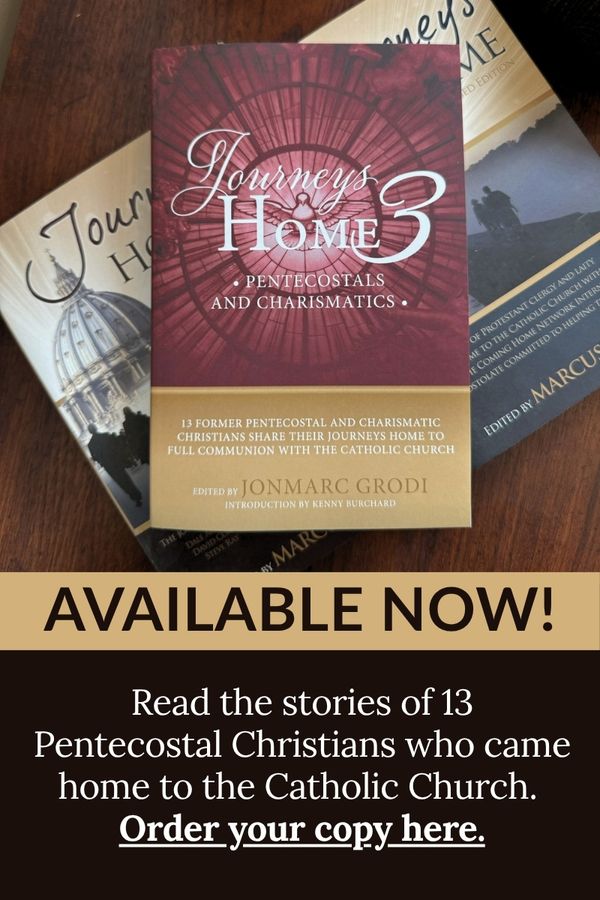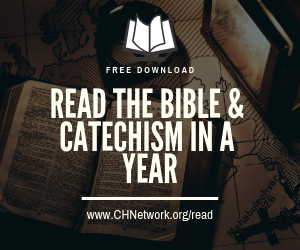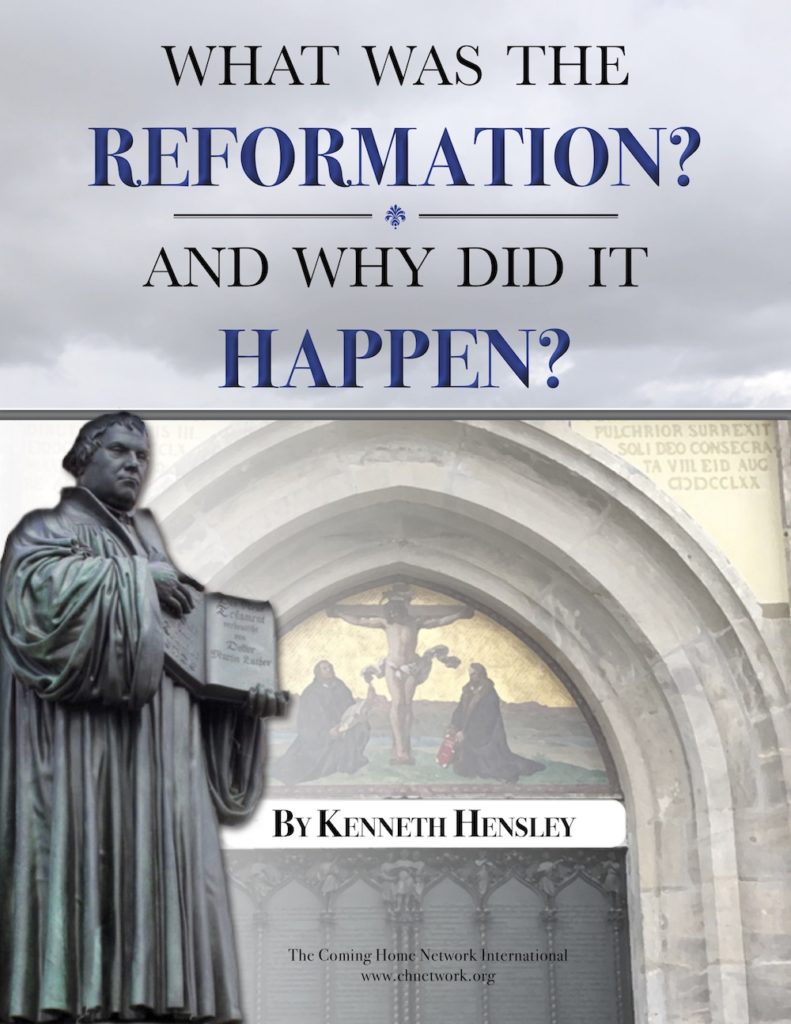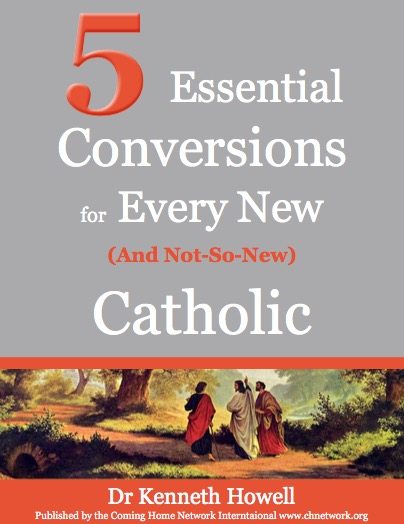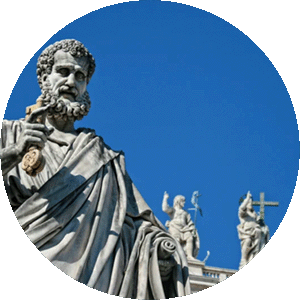
Like all later-in-life converts, the backstory of how this originally Lutheran kid became Catholic is a long one, with a few stops along the way. How did I come into the Church? The story contains two main parts: first, what happened to get me from there to here, and second, what I have come to appreciate about the Catholic Church.
Infant Baptism as a Lutheran
As is customary with Scandinavian Americans, ourfamily was solidly Lutheran.My church involvement was spotty, and I was more confused than not, even about the basic message of the Gospel. At least I knew enough to be confused. (My friend,Jon, had a similar experience. Growing up, he thought the Easter story was confusing. In his words, “How could the Apostles not see that Judas was the bad guy in the story, since his name was ‘Judas, the Scaredy Cat.’ With a name like that, the group should have seen that Judas was trouble!”)
Though I didn’t see it clearly until long after I came to an informed faith, my baptism as an infant was profound. My parents may have only understood the big picture when they had me baptized at six weeks of age. To me, for the longest time, that sprinkling contained nothing of spiritual value. The truth, though, was that a spiritual time bomb of faith was unleashed.
First, I had to learn that personal faith is the individual experience of coming to trust in Christ, different from the faith that comes from being connected with other like-minded believers. My experience with personal faith came from my year as an exchange student. I had won a competition at our high school and was chosen as the American Field Service exchange student of our class. I went from living in the Arizona desert to a small Norwegian village located an hour north of the Arctic Circle. The people were amazing, which made it doable, because not only was it cold, gray and windy, but from late October through mid-February there was no direct sunlight. I would come to realize that this time and place was a set-up from God — a parenthesis in time for reading Scripture, listening for God, praying and pondering the invitation of God to commit to Him. It was a fantastic year in many ways, mainly because that is where I came to faith in Jesus one-on-one.
During the extreme winter darkness experienced in that part of the world, I read and re-read the New Testament until I was familiar with the story of Jesus. God was calling me to come to Him, not just once in my lifetime, but to launch a lifestyle of moving forward in His presence. One night, after many readings of Scripture, it was apparent: Instead of just having information about God, I recognized an invitation from the Holy Spirit to know God personally and intimately. “Here I am!” was my prayer. What else is there, other than to offer ourselves fully to Him and to what He is doing?
The Jesus Movement shaped my early Christian life and set me on a trajectory for going into vocational ministry. If you’ve seen the film Jesus Revolution, you have an idea of what was happening in southern California, with tens of thousands of young people coming into the Christian faith. The sort of characters finding their way into a belief in Christ were newsworthy. These new arrivals usually had little or no church experience. The unofficial leader to many was a recently converted hippie named Lonnie Frisbee. As different as he was, Lonnie was an everyman figure that many could relate to, especially those not used to any version of organized religion.
While I was in Norway, someone randomly gave me a book about what God was doing in southern California at that time. The story captivated me, and I was determined to be included in this rare happening. Upon returning to the United States, I moved to Los Angeles to attend a Lutheran Bible school and hang around the Calvary Chapel scene to soak up as much of what was going on as I could.
When the lightning of God struck that generation, there was a seismic shift in the Christian world overall, among both Protestants and Catholics. For one, the kind of music congregations would sing became a new type of worship and liturgy. In addition, the more relaxed communication style present in many churches has become the standard operating practice from the model originating in this movement.
The Baby Boomer upheaval during this same time period was in large part due to unrest over the legitimacy of the Vietnam Conflict. All men 18 years of age and older were required to sign up for the mandatory draft. Although I was never called up by the military, having an assigned number was sobering. I began to think twice about the meaning of life and my longevity. When two of my relatives were killed in action, it hit me that no matter how long it may be in years, we are all still the grass that St. James refers to in his letter that is alive in the morning and gone by the end of the day (James 1:11).
When it came to the music of this era, I was captivated by The Lord’s Supper album by John Michael Talbot long before I’d ever attended a Mass. I was in Bible school in the mid-1970s when this album was released, and John Michael Talbot announced he had become a Catholic monk. My reaction to this news was two words — “A what!?” After years of playing back the album, I realized it was the Holy Mass set to catchy music. I found the music and words haunting. I was unknowingly singing the prayers of the Mass for decades before I began pondering conversion. In fact, when sharing my conversion story with Protestant friends, I usually tell them there ought to be a required warning label for Protestants: “THIS ALBUM MAY LEAD LISTENERS TO A CONVERSION.” In the words of St. Augustine, “When we sing, we pray twice.”
Turning my attention to the written word, Hungry For God by Ralph Martin was a significant book for me. The title alone opened a part of my mind and heart to the notion that there are Catholics who passionately love Jesus in the same way I did. When I ran across Ralph Martin’s books, I was at an odd place in my understanding of Catholicism. After connecting with Hungry For God, I began to seek out other Catholic authors, both current and historical. Scott Hahn was a timely voice each time I read him. G.K. Chesterton shaped my heart and mind. His witty insights shaped my faith and eventually paved my journey into the Catholic Church. Chesterton’s words especially gave me courage to take risks early in ministry: “Anything worth doing is worth doing poorly.” Through his wisdom, I learned to just get started, not waiting on the likelihood of 100 percent success. It became okay to do poorly at first and worry about perfection later.
My role in ministry at this time was to start up new congregations, usually from scratch. We did this by using a “parachute drop” strategy, arriving in a community without fanfare. Having few or no connections in the new city was the usual setting for us. My wife, Janie, and I would move into a community, meet a few folks here and there, and begin a Bible study, home group, or outreach. That pattern has been the spiritual “Rosetta Stone” of our lives. We are fluent in invitation, quickly making sense of the new community. My wife and I have always been enthused to connect with strangers and skeptics, then building a community. We have done that repeatedly on limited resources.
My Time in the Vineyard
When I started interacting with John Wimber, the originator of the Vineyard movement of churches (several thousand congregations worldwide as of this writing), I began to see the church as the entire activity of God across the spectrum of faith specifics. With intense emotion in his voice, I heard John comment that the greatest tragedy in the history of the church was her division into factions due to the Reformation, as championed by Martin Luther. God used all that happened on the Protestant side and the later Counter-reformation launched among Catholics, but overall, it resembled a tragic divorce. Coming to the macro picture of God’s work on earth was a paradigm shift — a correction from my version of the church to something closer to God’s big picture invitation.
The Vineyard group of churches held their movement-launching conference just as we were stepping out to plant a new congregation in Cincinnati. Going into this event, I was in a period of reflection over this move and our new church launch. I had already experienced incredible frustration in stepping out to plant a church in Oslo, so I wasn’t eager to test our readiness unless it was under the direction of God.
Part of the conference included the showing of a 20-minute documentary video that, though technically rough, was profound. Fr. Rick Thomas and a group from his Catholic parish in the El Paso area did a Christmas Day outreach across the border in Juarez, Mexico. Burritos were on the menu and in great supply — or so they thought. Instead of the 100 people they expected, they had a few dozen more who came for the free meal. After feeding all 100 plus the unanticipated extra crowd, there were still burritos remaining for the servers. They somehow served considerably more burritos than they made. They called it the “miracle of the expanding burritos.” The film captured my heart and imagination. I don’t know if anyone else present had the same idea as me, but it came clearly: imitate Fr. Thomas, and you will capture the hearts of everyday people in your city. Those became our marching orders in starting out in Cincinnati.
What started as a kernel of an idea with Fr. Thomas became something broader with momentum. Servant evangelism was actually showing people God’s love, kindness, and generosity while simultaneously telling them about Him. It never grew old seeing people’s reactions anywhere around the country and the world; a light went on when we reached out to others in practical ways with the “kindness of God that leads to a radical life change” (Romans 2:4, NASB & MSG).
Based on my experiences with feasible and fun outreach, I wrote a story about our success and discoveries in starting outreaches from scratch: Conspiracy of Kindness. God’s kindness is perhaps his best writing implement for communicating his presence and love to hearts. I am reluctant to use the line “God told me” unless it strikes a chord and bears fruit over time. I can say with confidence the clearest, most strategic message I’ve received boiled down to three directives and promises from God:
1. “You prayed for a microphone, but I’m giving you a toilet brush to communicate the message.”
2. “Love the discounted people first — then your problem will be what to do with all those coming in.”
3. “Don’t start a church. Change a city.”
Outreach project ideas began to flow as I pondered what God was saying. An outreach car wash that was 100 percent free, with no donations accepted, was our first attempt — serving to give a sample of God’s presence and love in a practical way. The car wash projects later morphed into the idea of doing the exact project God had challenged me with: cleaning public toilets. We went to businesses, restaurants, A.A. meeting locations, bars, and retail establishments to offer a free toilet spiff up. The response was usually memorable! After cleaning many hundreds of toilets around the U.S. and beyond, I can testify that when a believer offers to clean the employee restroom, we gain their attention and favor immediately!
Cleaning toilets was not just a powerful offer to a business. It piqued curiosity. The question came up more than a few times: “Is this a joke? Where’s the hidden camera?” A common response to our service has been, “I’ve always believed in that Jesus — the one who lived humbly and served.” It turns out that a lot of people are looking for “that Jesus.”
The pattern of people staying away from church attendance by the thousands shifted to them coming in by the several thousands over a short span of time in church years. Over a decade we shot up from five people in a little Bible study group to 4,000 worshipping over seven weekend services; ultimately, we grew to yet several thousand more weekly attendees. That sort of momentum is exciting, in a sense. But to me, the feeling of spiritual responsibility was growing emotionally uncomfortable. I often thought that I was the one most responsible for the spiritual welfare of all these people who had shown up.
One day, I had a chance encounter at a colossal computer center store. Of the dozens of aisles and hundreds of customers there, I found myself next to the Most Rev. Daniel Pilarczyk, the Archbishop of Cincinnati. We recognized one another, and he introduced himself.
“Hello, Pastor. I understand you have a big church. Right?”
I replied, “Yes, sir, I guess we do.”
“And you have a lot of our Catholic people, right?”
“Yes, sir, we have a lot of Catholics at our place.”
“I was just wondering — when will you send them back?”
I responded from my heart, “I don’t know how to do that. I don’t see them as my people. Tell you what. I will, in all seriousness, ponder this. Maybe something is up.”
I never saw those at the Vineyard Church as my people. They are always God’s people — full stop. To see them otherwise is an act of manipulation. Walking away from that spontaneous chat, I felt upended in the best way possible. It was time to reconsider whose people these were and how to get them home.
Medical Catastrophe and the Felix Culpa of COVID
Not long after I turned 42, I experienced a medical-surgical disaster during an operation to remove my gall bladder. According to my surgeon, I had experienced some pains that seemed like a textbook gall bladder issue. After five medical tests and no sign of my gall bladder, the surgeon concluded I needed to remove “what was surely there somewhere.” His advice was to have the surgery sooner than later. In his opinion, the lack of evidence of gall stones made it likely I’d have an emergency surgery.
The doctor who had my case was on the younger side but came highly recommended by my trusted family doctor, so I followed his advice. One problem became apparent pretty quickly — I am one of the rare cases of people born without a gall bladder. To be born minus a gall bladder isn’t unheard of, but it is a rarity that occurs only once in about every 30,000 patients.
It’s still up for debate how it happened, but in the first minutes of the laparoscopic procedure, what should have been a small incision by my navel went deep enough to hit my descending aorta. Though my aorta is about the diameter of my thumb and located close to my spine, the device penetrated all the way through, from top to bottom. My blood pressure plummeted to 30/10 (a healthy reading is 120/80). After 75 minutes, my heart stopped. For those several minutes, I saw and heard things better read about in detail in my memoir, The Day I Died, for the whole story.
Fast forward to 2020, when COVID-19 hit the world. The pandemic was a bittersweet time for me. A number of acquaintances and a close friend didn’t survive the ordeal. On the other hand, if it hadn’t been for that down time, I’d likely still be limping along, growing increasingly jaded and not fitting into a family of faith.
Felix culpa (“O happy fault”) is a Latin phrase used to describe those times in life when we experience loss, but something good comes out of it. Romans 8:28 may be a verse you have memorized: “We know that in everything God works for good with those who love him, who are called according to his purpose.” When God said “all things” will be redeemed, he meant even the tragedy of COVID. My experience with the months and eventually years of COVID was not much different from staring into a mirror — not gazing at oneself on the outside, but a more profound interior gaze that led me to ask myself a couple of moving questions: What am I enthusiastic about that I need to dive deeper into, and what am I less than stoked about that I need to exchange for what is on God’s menu for me?
During COVID, it became apparent that my “Evangelical family” held values, perspectives, politics, and life directions that were clearly different from mine. As politics have increasingly seeped into the culture of that part of the church, there was less and less grace for me to remain, much less be a leader there. The COVID “break” was a chance to ponder where I best fit into God’s trajectory for the rest of my life.
My final stepping stone into the Catholic Church came from the encouragement and invitation of a couple of high school friends from a small town in Arizona, Colleen and Jerry DeRose. They had been raised Catholic, but spent years away until the Holy Spirit drew them back. Their journey gave light to my own as their words and occasional nudge kept me on the path across the river Tiber. Without a doubt, Colleen and Jerry’s coaching and encouragement sped up my journey tremendously. Through them, I was introduced to books that would significantly help me understand what I was learning about the Catholic Church and quicken the pace of my journey as those hurdles were overcome. Scott Hahn’s books became particularly helpful in escorting me into the Church. They reminded me that to be a Catholic is to join an ancient faith, which was a 180 degree shift for me. It has given me the perspective of millennia, not just decades or even centuries. “We’ve had the same pastor for 2,000 years!”
The DeRoses were patient with me as I struggled with other doctrines and teachings. Understanding Mary, in particular, was a challenge. As a dyed-in-the-wool Evangelical, Mary wasn’t often present beyond a cursory Christmas reading of Scripture, and even then she was more of a detail along the way in Christmas messages. When I said to Colleen and Jerry, “What’s the deal with Mary?” — a line that would warrant a phone hang up with some — they didn’t turn away or become offended. Their patience and willingness to help me as I was attempting to comprehend a concept mostly foreign to me until now led to a beginning point of understanding. I was realizing that the Holy Mother is worthy of honor in much the same way as when your own mother enters a room.
What began as a result of a high school scholarship in Globe, Arizona kicked off a decades-long journey that landed in Globe again — and in a move to the Catholic Church. God is good — all the time!
Some Things I’ve Learned
I am excited and overwhelmed by the learning curve I find myself in now and anticipate that I will likely be in for the rest of my life. There is much about the Church that I don’t yet grasp, but there are also parts I have come to understand, things that deeply inspire me.
Doctrine, history, and tradition have come to mean a great deal to me, now that I am Catholic. I’ve come to see that the Tradition of the Church has little to do with the idea that “this is the way it is, because that’s how we’ve always done things.” Living out the value of doctrinal stability is stellar. With the Magisterium (the Church’s teaching authority) as a central backbone to hold the Church together theologically, there is less need to re-examine or debate doctrinal issues incessantly.
When it comes to structure and teaching, I like knowing that, on various issues and doctrines, I can stand on the shoulders of like-minded fellow believers who have thought through these issues for hundreds of generations since the advent of the Church two millennia ago. At the same time, I find it brilliant that, within the enormous scope of the Catholic Church, there is an allowance for uniquely wired subgroups (“sodalities,” we call them) with a specialized calling and ministry focus.
My understanding of conversion has also grown. Romans 2:4 in The Message translation says that the kindness of God leads to “a radical life change.” A radical change is a complete transformation from the inside out. The prophet Joel spoke of the power of conversion, saying that God will “restore the years the locusts have eaten” (Joel 2:25–27 MSG). He will pull off a complete restoration, even when that requires a whole new re-creation.
That image of beginning a one-on-one relationship with God is fitting. We come with nothing to offer other than our love and availability to God in a love-based relationship. God has considered that level of change from the beginning of his inviting us into his kingdom. I am grateful to be connected with those who believe in being converted personally and then working as “converters.” I realize that, when we convert, we start to notice the beginning of a “radical life change” unfolding.
My experience with Protestant groups often focused almost entirely on our individual relationship with Jesus. The Catholic Church has shown me the importance of communal faith as well — to become part of a “group faith” that also comes with a radical life change. It’s no mistake that there are half a dozen plural pronouns in the Lord’s Prayer that Jesus gave us in Matthew. “Our Father… give us our daily bread… forgive us our trespasses… lead us not into temptation… deliver us from evil.” To be strong in the Lord, I have come to understand that I must identify as an integral part of the unified body of Christ with my brothers and sisters.
Through my own experience of conversion and working with people coming toward a personal faith, I have seen that converts are often developed slowly, through more of a process than an instant knee-jerk version of change. It was certainly true in my own life. Our call as believers is to nudge those around us onto the same life-giving path we are walking and let the Holy Spirit do the rest.

